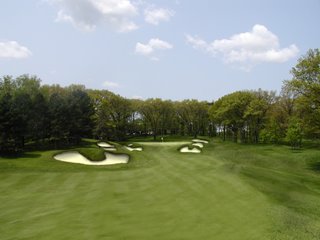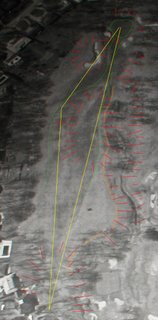18 Holes – Day 8# - 4th at St. George’s (NLE)

A look from the crown down to the original gren site
I thought it would be fascinating to do one hole that no longer plays the way it was designed.
The 4th at St. George’s Golf & Country Club used to be called one of the greatest holes in Canada. It was a medium length par four that was an interesting option off the tee. You could play safely to the left side down in the valley and face a blind approach over a bunker strewn hill in front of the green; or take a big risk hitting to a crowned upper fairway with deep trouble on the right to gain visibility of the green and the ideal angle for the approach. In my mind it was one of the finest holes Stanley Thompson ever designed. It was a brilliant use of the natural land and its loss represents the disastrous results that come from altering a course to hold a major championship.
The old 4th was all about position. There were no bunkers in play from the tee, just one prominent landform to think about. There was little room on top of the crown but the landing was clear from the tee. There was a lot to risk since a slight miss right put you in a deep ravine with long grass that ran parallel to the fairway, but the reward was an open approach directly into the slope of the green. So why take the risk off the tee? If you played safely to the left the natural slope took you to the left edge of the fairway. In your way stood a large hill of about 20 feet high with a series of deep bunkers. Getting in one of those bunkers was a disaster considering the length of the next shot. Hitting the ball safely over was not enough, the green was a very tough target surrounded by trouble. The front of the green fell right and into a deep swale in front, the left front had a very deep bunker, and the back of the green also has a bunker and deep rough The green itself (which is still there!) fell sharply from the back to the front right, meaning a long approach was an impossible up and down. Having to be that precise is a lot to ask, couples with being a blind shot, makes it even more intimidating – and that is why the risk was worth it from the tee.
So why take the risk off the tee? If you played safely to the left the natural slope took you to the left edge of the fairway. In your way stood a large hill of about 20 feet high with a series of deep bunkers. Getting in one of those bunkers was a disaster considering the length of the next shot. Hitting the ball safely over was not enough, the green was a very tough target surrounded by trouble. The front of the green fell right and into a deep swale in front, the left front had a very deep bunker, and the back of the green also has a bunker and deep rough The green itself (which is still there!) fell sharply from the back to the front right, meaning a long approach was an impossible up and down. Having to be that precise is a lot to ask, couples with being a blind shot, makes it even more intimidating – and that is why the risk was worth it from the tee.
What can we learn? Rather than routing the hole only through the natural valley, Thompson used the crown to best effect. By tucking the green behind the large ridge, instead of on top, he required the careful placement onto the crown as the only way to make the green visible on the approach. Having to flirt with the ravine on the right adds to the challenge of the hole. This unconventional routing approach made for a very strategic hole.
Next Hole: http://thecaddyshack.blogspot.com/2006/06/18-holes-day-9-8th-at-royal-troon.html

No comments:
Post a Comment